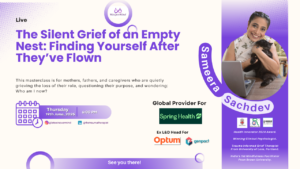Have you ever tried to meditate and found yourself mentally drafting your grocery list or rehashing a work conversation? It’s okay, we’ve all been there. Meditation might seem simple, just sit, breathe, and “clear your mind,” right? But the reality often feels more like herding cats. The good news? Starting meditation doesn’t require perfection; it only requires you.
Why Meditation Feels Daunting
For most people, the biggest hurdle is the misconception that meditation means completely silencing your thoughts. Let’s clear that up right now: meditation is not about eliminating your thoughts. It’s about noticing them, letting them float by like clouds, and returning to your center.
One Client’s Journey: Rachel’s Five-Minute Rule
Let me share a story. I had a client—let’s call her Rachel, who came to me with that familiar “I want to try meditation, but I’m terrible at sitting still” frustration. She’d watched videos, read guides, and even downloaded apps, but every time she tried to meditate, her mind would race, and she’d feel like she was failing.
One day, she blurted out, “Maybe meditation just isn’t for people like me.”
That hit home. Rachel wasn’t the problem, her expectations were. So we hit reset. Instead of aiming for some picture-perfect Zen moment, I asked her to try something simpler: sit for two minutes every morning with her cup of coffee. No fancy poses, no strict rules, just notice the warmth of the mug, the aroma, the taste, and her breath.
A few weeks later, she walked into our session looking lighter. “I don’t know what changed,” she said, “but mornings feel less rushed, and I don’t lose my cool as easily.” Meditation wasn’t about clearing her mind or finding enlightenment, it was about carving out a moment of calm in the chaos.
The takeaway? You don’t need to “be good” at meditation to benefit from it. Start where you are, with what you have, and let it evolve.
Steps to Ease Into Meditation
1. Find Your Space
You don’t need a zen garden or fancy cushions to meditate, just a space where you feel at ease. It could be your favorite chair, a quiet corner of your home, or even a sunny spot in your garden. Add a blanket, a candle, or some soft music if it helps set the mood.
2. Set Realistic Expectations
Forget the idea that you must meditate for 30 minutes to feel benefits. Start with just one or two minutes. The key is consistency, not duration.
3. Choose What Works for You
Not everyone thrives in silence. If sitting still feels awkward, try guided meditations through apps like Calm or Headspace. You might even find mindfulness in movement—walking slowly, focusing on each step, can be just as meditative as sitting cross-legged.
4. Breathe, Observe, Repeat
The simplest meditation is focusing on your breath. Inhale deeply, exhale slowly, and notice how your body feels. Your mind will wander, and that’s okay. The goal isn’t to stop it; it’s to bring your focus gently back to your breath.
Why It’s Worth the Effort
Meditation isn’t just a trendy wellness buzzword; it’s a proven way to reduce stress, improve focus, and boost emotional resilience. And here’s the thing: it’s not about doing it perfectly. It’s about creating a moment for yourself in the middle of life’s chaos.
A Gentle Invitation
If you’ve been thinking about meditating but feel unsure where to start, let’s talk here. As someone who’s helped others find their way, I’d love to guide you through the process and make it work for you.
Meditation doesn’t have to be complicated, it just has to be yours.


